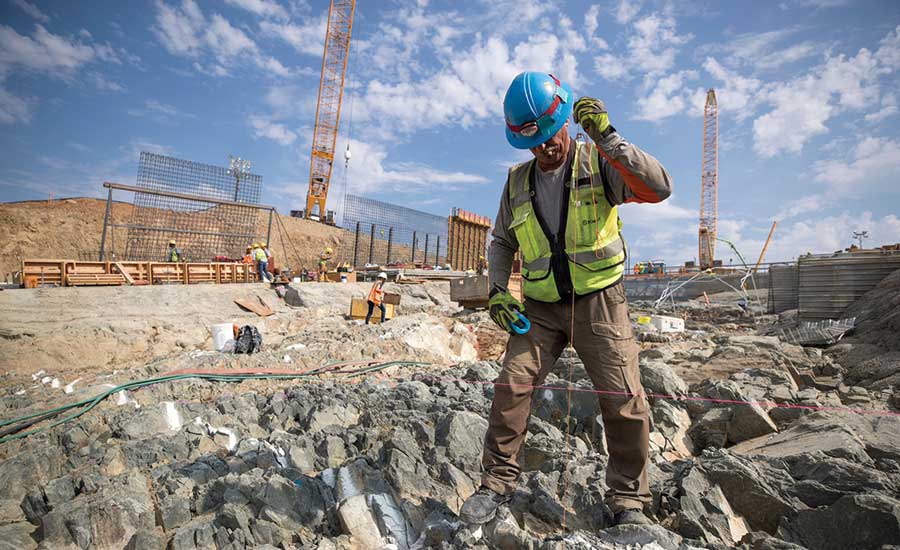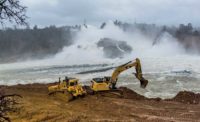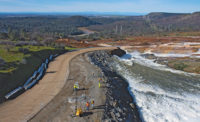If initial lessons included in an interim status report on the cause of February’s failure of the main spillway at California’s Oroville Dam are heeded, hundreds of U.S. dams more than 50 years old may have to be re-examined and upgraded.
The Independent Forensic Team’s Sept. 5 report pinned much of the blame for the failure on the 1968 dam’s design and construction. A 40-ft-wide concrete slab was uplifted and removed, resulting in a blowout of the underlying “highly weathered rock” in the chute of the tallest earthen dam in the country. The failure led to the evacuation of almost 188,000 people and millions of dollars in downstream damage from emergency releases.
Members of IFT toured the site, interviewed DWR staff and examined initial design and construction records. The trigger for the failure could be traced to high-velocity spillway flows injecting water into slab surface features, such as open joints or unsealed cracks, the report noted. The failure occurred during heavy rainstorms that resulted in flows of 54,500 cu ft per second through the gated spillway. The 1,700-ft-long spillway crest was rated with a discharge capacity of 250,000 cfs. The report also showed that some of these weak spots may have been previously repaired areas. Investigators ruled out cavitation, impacts of groundwater and seismic damage.
Although regular physical inspections of the facility were not adequate to reveal the weaknesses, inspectors applying current best practices might have been able to warn of the risks. IFT concluded that “comprehensive periodic reviews of original design and construction, taking into account comparison with the current state of the practice, are needed for all components of dam projects.” Such a review would have “connected the dots” before the damage was done. One possible missed indicator cited was excessive drain flow rates due to under-slab erosion.
The California Division of Dam Safety identified 93 dams in the state similar to Oroville in size, construction and age. The Dept. of Water Resources directed dam owners to complete a re-evaluation of their spillways, including a historical review back to the original design and construction, said Erin Mellon, spokeswoman for California DWR, owner of Oroville Dam and operator of hundreds of others around the state.
“We are absolutely reassessing our procedures in light of Oroville, as I’m sure all dam owners are,” Mellon says. “The entire dam-safety community will learn a great deal from what transpired in February.”
General contractor Kiewit Infrastructure West. Co. is scheduled to complete the first phase of a $500 million-plus repair, including emergency work before Kiewit was awarded the contract, to place 2,270 ft of reinforced, structural concrete on the main spillway by Nov. 1. This job includes 730 ft of the main spillway leading to the radial gates, which are being patched, reinforced and left in place this year but will be removed and reconstructed with structural concrete in 2018. It also includes more than 5,000 ft of underdrains in the structural-concrete sections, one of the problems called out in the independent report.
Water flows also eroded part of the emergency spillway in February, when it was used for the first time in the dam’s history and almost immediately began showing signs of headward erosion on the 1,450-ft earthen slope. Kiewit crews are building a secant pile cutoff wall in case the spillway is put to use once again.
Once the erosion was detected, DWR set up multiple portable cameras to monitor both spillways, Mellon says. Cameras in helicopters and drones supplemented monitoring by the ground-level cameras during the emergency. Even with all this technology in place, continuous monitoring at night was difficult, as the drones were not equipped with infrared cameras and the helicopters were limited by the number of hours they could be in the air. These challenges and limitations of working at night are not unique to this emergency, Mellon noted.





Post a comment to this article
Report Abusive Comment